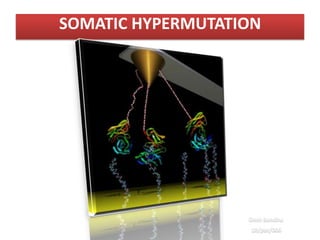
Somatic hypermutation
- 1. SOMATIC HYPERMUTATIONSOMATIC HYPERMUTATIONDeshBandhu 10/pbt/006
- 2. Contents 1-Introduction 2-Molecules involve in SHM 3-Model of SHM 4-Future Directions
- 3. Introduction somatic hypermutation (SHM) is a diversity generating, regulated cellular mechanism displayed by the adaptive immune response. Somatic Hypermutation adds diversity in already Rearranged Gene Segments. Somatic hypermutation occurs at a frequency of 10¯3/base pair/ generation, than the spontaneous mutation rate about 10⁻8/bp/generation.
- 4. This Rate is higher hence the name, hypermutation. These mutations occur mostly at “hotspots” in the DNA, known as hypervariable regions. These regions correspond to the complementarity determining regions, the sites involved in antigen recognition on the antibody.
- 5. These mutation result from nucleotide substitution rather than addition or deletion. They influence the process of affinity maturation of B cells. Affinity maturation leads to increase the affinity of antibodies for a particular antigen.
- 8. Molecules involved in SHM IgM antibodies expressing V regions that have undergone SHM, as well as IgG and IgA antibodies with no somatic mutations. Activation-induced cytidinedeaminase: A B cell-specific protein required for SHM. Uracil N-glycosylase: Removing uracil generated by AID deamination.
- 9. Mismatch repair proteins: Mismatch repair (MMR) normally maintains genomic integrity. MMR eliminates mutations that arise spontaneously in the genome. Error-prone DNA polymerases: increase mutation rate.
- 10. Model of somatic hypermutation
- 12. SHM Plateform
- 13. To Produce New Fluorescent Proteins Tsien’s group has cloned a red fluorescent protein (RFP) into human B-cells and allowed them to make variants that could then be isolated based on their colors by flow-cytometry.
- 14. Questions??
